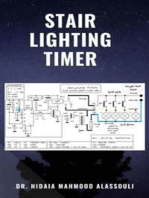Lecture 12 Circuit Breaker Application
Uploaded by
Delmar FerrerLecture 12 Circuit Breaker Application
Uploaded by
Delmar FerrerLecture 12: Circuit Breaker
Application
Circuit Breakers
ANSI Simplified Methods
Momentary Duty and Ratings
Interrupting Duty and Ratings
EE 751 Circuit Breakers 1
Theory
• Sudden three-phase short circuit on a
generator with external reactance Xe
ia(t) = 2 Iac(t) cos(t+) + 2 I" e-t/Ta
Iac(t) = (I"-I')e-t/T"d + (I'-I)e-t/T'd + I
I"=E/(X"d+Xe)
I'=E/(X'd+Xe)
I=E/(Xd+Xe)
T"d=T"do(X"d+Xe)/(Xd+Xe),
T'd=T'do(X'd+Xe)/(Xd+Xe)
EE 751 Circuit Breakers 2
E = prefault voltage (rms) usually 1.0 pu
Idc(t) = 2 I" e-t/Ta
Irms(t) = [Iac(t)2 + Idc (t) 2]1/2
This is rigorous:
Momentary duty is Irms at 0.5 cycle and
interrupting duty is Irms at contact parting
time of breaker
Usually use simplified methods, discussed
next
EE 751 Circuit Breakers 3
Circuit Breakers
• Basically, an AC circuit breaker is a
piece of switchgear that can
– withstand the momentary short-circuit
current
– interrupt the short-circuit current at the
current zero following contact parting
– withstand the transient recovery voltage
across its open contacts
EE 751 Circuit Breakers 4
Interrupting time
Contact parting time
Tripping Opening Arcing
delay time time
t
Initiation Trip Primary Arc on
of short circuit contacts primary
circuit energized part contacts
extinguished
Sequence of events in AC circuit breaking: after relays
detect fault and energize trip coil, breaker contacts open,
arc is established and then extinguished at a current zero
EE 751 Circuit Breakers 5
Simplified Methods (ANSI)
• Circuit breakers in the US are rated per
ANSI standards, by
– momentary (or first-cycle or closing and
latching) rating, and
– interrupting rating on either:
• total current rating (older breakers)
• symmetrical current rating (new breakers)
– We compute both first cycle and
interupting duties to compare with ratings
EE 751 Circuit Breakers 6
Simplified Method
• Simplified method method is based on
calculation of Thevenin reactance Xth
at the point of the fault, then I = E/Xth
• If resistance is significant, calculate
Zth = (Rth2 + Xth2)1/2, and I = E/Zth
EE 751 Circuit Breakers 7
First-cycle duties
• Breakers that are rated on a total
current basis
– momentary rating must exceed the
calculated first-cycle duty
• Breakers that are rated on a
symmetrical current basis
– closing and latching capability must
exceed the first-cycle duty
EE 751 Circuit Breakers 8
First-cycle duties
• Look up machine reactances from
tables in ANSI standards
– HV (and MV) circuit breakers (above
1000 V) use
• ANSI C37.5 (total interrupting rating)
• ANSI C37.010 (symmetrical interrupting
rating)
– LV circuit breakers and fuses use
• ANSI C37.13
EE 751 Circuit Breakers 9
First-cycle duties for HV and MV circuit breakers
Turbo-generators, hydro-
1.00 Xd"
generators, and condensers
Hydro-generators (no
0.75 Xd'
damper windings)
Synchronous motors 1.00 Xd"
above 1000 hp at
1800 rpm or less
1.00 Xd"
above 250 hp at
3600 rpm
Induction motors 50 - 1000 hp at
1800 rpm or less
1.20 Xd"
50 - 250 hp at
3600 rpm
Below 50 hp neglect
EE 751 Circuit Breakers 10
First-cycle duties
• Compute I" using the appropriate reactances
in the short-circuit study
• The first-cycle duty is 1.60 I"
– approximates the duty on the breaker during the
first half cycle of short-circuit current.
– breaker must be able to close and latch, while
withstanding the mechanical forces produced
by this large current
– compare to breaker momentary rating
EE 751 Circuit Breakers 11
LV CB and Fuses
• For LV circuit breakers and fuses, see
ANSI C37.13 for reactances adn
multipliers to estimate the momentary
current
• This is also summarized in section
2.7.4 of the notes
EE 751 Circuit Breakers 12
System X/R Ratio
• If a fault is near a large generator, the
system X/R ratio can be large
– Simplified method needs some
modification for X/R >15, then either:
• derate breaker interrupting rating by 80%, or
• use the method given in ANSI C37.010
– We need to discuss the X/R ratio
calculation
EE 751 Circuit Breakers 13
System X/R
• Every generator has its own X/R, but a
safe approximation is as follows:
– Find the Thevenin reactance seen from
the fault, neglecting all resistances, call
that Xth
– Find the Thevenin resistance seen from
the fault, neglecting all reactances, call
that Rth
– Then X/R ratio = Xth/Rth
EE 751 Circuit Breakers 14
Interrupting Rating
• Total current basis (older breakers)
– Interrupting rating based on total
(asymmetrical) current including ac and
dc components. See notes section 2.7
• Symmetrical current basis (new
breakers)
– Interrupting rating based on symmetrical
current (ac component only)
EE 751 Circuit Breakers 15
Symmetrical interrupting duties for HV and MV circuit breakers
Turbo-generators, hydro-
1.00 Xd"
generators, and condensers
Hydro-generators (no
0.75 Xd'
damper windings)
Synchronous motors 1.50 Xd"
above 1000 hp at
1800 rpm or less
1.50 Xd"
above 250 hp at
3600 rpm
Induction motors 50 - 1000 hp at
1800 rpm or less
3.00 Xd"
50 - 250 hp at
3600 rpm
Below 50 hp neglect
EE 751 Circuit Breakers 16
Symmetrical interrupting rating
• Calculate I = E/X for 3-phase and for
1-phase-ground short circuits
• Circuit breaker is adequate for any X/R
if
3-phase sc I 80% of the interrupting
rating,
and
1-phase-ground sc I 70% of the
interrupting rating
EE 751 Circuit Breakers 17
Symmetrical interrupting rating
• Calculate X/R, if it exceeds 15 then
– Look up multiplying factor from ANSI
C37.010 (also Fig. 2.7.3 in notes)
– Multiply the factor by I" to estimate the
breaker interrupting duty
– If the interrupting duty interrupting
rating, then the breaker is adequate
• If X/R 15, then multiplying factor is
1.00
EE 751 Circuit Breakers 18
Breaker Ratings
• ANSI C37.06 has ratings for HV
breakers with symmetrical interrupting
ratings:
– rated max voltage
– rated voltage range factor K
– rated short-circuit current
– plus other ratings
EE 751 Circuit Breakers 19
K factor
• If K = 1, then interrupting rating =
rated short-circuit current
• If K > 1, then interrupting rating is
inversely proportional to the operating
voltage, up to a limit of K times the
rated short-circuit current
– Breaker has an operating region with a
MVA rating
EE 751 Circuit Breakers 20
Example
• Vmax = 15 kV, Iscrated = 19.0 kA,
K=2.27, apply at 13 kV:
Interrupting rating = 19 kA15 kV/13 kV =
21.9 kA
Check maximum int rating = KIscrated =
2.2719.0 kA = 43.1 kA
Interrupting rating = 21.9 kA
EE 751 Circuit Breakers 21
45
40
Iint rated( V ) 35
kA
30
Isc rated K
kA
25
20
15
0 5 10 15
Vmax
V K
kV kV
EE 751 Circuit Breakers 22
• As V decreases from its maximum,
the interrupting rating increases up to
a maximum of Krated sc current at
Vmax/K
• Note that the close and latch
capability is 1.6 K rated short-
circuit current
• See several examples in section 2.7
of the notes
EE 751 Circuit Breakers 23
You might also like
- Applications To Sizing Circuit Breakers (ANSI C37)100% (1)Applications To Sizing Circuit Breakers (ANSI C37)22 pages
- Evaluating Generator Breakers Short-Circuit Duty100% (1)Evaluating Generator Breakers Short-Circuit Duty7 pages
- Comparison of ANSI and IEC 909 Short-Circuit Current Calculation ProceduresNo ratings yetComparison of ANSI and IEC 909 Short-Circuit Current Calculation Procedures7 pages
- Evaluating Generator Circuit Breakers Short-Circuit Duty Using IEEE C37.010 and C37.013100% (1)Evaluating Generator Circuit Breakers Short-Circuit Duty Using IEEE C37.010 and C37.0137 pages
- Luanshya Technical and Business College Management Board Diploma in Electrical Engineering Electrical Instrumentation (Dee 231)No ratings yetLuanshya Technical and Business College Management Board Diploma in Electrical Engineering Electrical Instrumentation (Dee 231)9 pages
- Ieee Application Guide For Ac Highvoltage Circuit Breakers RatedNo ratings yetIeee Application Guide For Ac Highvoltage Circuit Breakers Rated54 pages
- 1.5. IEEE C37.04 ESTRUCTURA DE CLASFICACION ESTANDAR PARA INTERRUPTORES DE ALTO VOLTAJE DE CA EN CORRIENTE SIMNo ratings yet1.5. IEEE C37.04 ESTRUCTURA DE CLASFICACION ESTANDAR PARA INTERRUPTORES DE ALTO VOLTAJE DE CA EN CORRIENTE SIM29 pages
- ANSI/IEEE Calculation Methods: Standard ComplianceNo ratings yetANSI/IEEE Calculation Methods: Standard Compliance14 pages
- Reclosers: Comparison of Recloser and Breaker StandardsNo ratings yetReclosers: Comparison of Recloser and Breaker Standards8 pages
- A 25000 Kva 11kv Generator With 5 THE SELECTION OF CIRCUIT BREAKERNo ratings yetA 25000 Kva 11kv Generator With 5 THE SELECTION OF CIRCUIT BREAKER4 pages
- IEEE Standard Test Procedure For AC High-Voltage Circuit Breakers Rated On A Symmetrical Current Basis0% (1)IEEE Standard Test Procedure For AC High-Voltage Circuit Breakers Rated On A Symmetrical Current Basis60 pages
- MV Circuit Breaker Guide - Ansi Vs Iec Comparison100% (1)MV Circuit Breaker Guide - Ansi Vs Iec Comparison18 pages
- Unit-6 Circuit Breakers (Switchgear and Protection)No ratings yetUnit-6 Circuit Breakers (Switchgear and Protection)84 pages
- Resumen C37 010 Aplicacion de Breaker Disenados IC Simetrica PDF100% (1)Resumen C37 010 Aplicacion de Breaker Disenados IC Simetrica PDF9 pages
- Special Requirement of IEEE C37.013 For Generator Circuit Breaker Applications100% (1)Special Requirement of IEEE C37.013 For Generator Circuit Breaker Applications22 pages
- IEEE Guide For Calculation of Fault Currents For Application of AC High-Voltage Circuit Breakers Rated On A Total Current BasisNo ratings yetIEEE Guide For Calculation of Fault Currents For Application of AC High-Voltage Circuit Breakers Rated On A Total Current Basis4 pages
- Basic Short-Circuit Current CalculationNo ratings yetBasic Short-Circuit Current Calculation10 pages
- Determining Power Circuit Breaker Interrupting Ratings: Application Paper AP01301001ENo ratings yetDetermining Power Circuit Breaker Interrupting Ratings: Application Paper AP01301001E2 pages
- ANSI/IEEE Calculation Methods: Standard ComplianceNo ratings yetANSI/IEEE Calculation Methods: Standard Compliance36 pages
- Schneider MV Design Guide Switchgear DefinitionNo ratings yetSchneider MV Design Guide Switchgear Definition21 pages
- Reference Guide To Useful Electronic Circuits And Circuit Design Techniques - Part 2From EverandReference Guide To Useful Electronic Circuits And Circuit Design Techniques - Part 2No ratings yet
- Boat Maintenance Companions: Electrics & Diesel Companions at SeaFrom EverandBoat Maintenance Companions: Electrics & Diesel Companions at SeaNo ratings yet
- Reference Guide To Useful Electronic Circuits And Circuit Design Techniques - Part 1From EverandReference Guide To Useful Electronic Circuits And Circuit Design Techniques - Part 12.5/5 (3)
- FAMY'S DEVELOPMENTAL PLAN - 2030 Final Presentation 09292022No ratings yetFAMY'S DEVELOPMENTAL PLAN - 2030 Final Presentation 0929202215 pages
- GNSS-FW3.01 ReleaseNotes (UBX-16000319) PublicNo ratings yetGNSS-FW3.01 ReleaseNotes (UBX-16000319) Public12 pages
- SIT374 - Assignment 1 (Azzino's Pizza Project Proposal)No ratings yetSIT374 - Assignment 1 (Azzino's Pizza Project Proposal)8 pages
- Lunet: A Deep Neural Network For Network Intrusion DetectionNo ratings yetLunet: A Deep Neural Network For Network Intrusion Detection8 pages
- Intersection Control: 8.1 General Concepts of Traffic Control 8.2 Conflict Points at IntersectionNo ratings yetIntersection Control: 8.1 General Concepts of Traffic Control 8.2 Conflict Points at Intersection19 pages
- Department of Electronics and Communication Engineering: 6 Semester Online LAB SESSION ReportNo ratings yetDepartment of Electronics and Communication Engineering: 6 Semester Online LAB SESSION Report4 pages
- PDF Blockchain, Big Data and Machine Learning: Trends and Applications First Edition Kumar DownloadNo ratings yetPDF Blockchain, Big Data and Machine Learning: Trends and Applications First Edition Kumar Download53 pages
- BA5018 - Unit II - Organizational DesignNo ratings yetBA5018 - Unit II - Organizational Design133 pages
- Khan, 2023 - Review Design and Optimization of Lithium-Ion BatteryNo ratings yetKhan, 2023 - Review Design and Optimization of Lithium-Ion Battery33 pages
- Weibull Analysis in Software Reliability EngineeringNo ratings yetWeibull Analysis in Software Reliability Engineering3 pages
- ETI - RDMP - Mechanical Incinerator - Project Exc. PlanNo ratings yetETI - RDMP - Mechanical Incinerator - Project Exc. Plan21 pages
- Applications To Sizing Circuit Breakers (ANSI C37)Applications To Sizing Circuit Breakers (ANSI C37)
- Comparison of ANSI and IEC 909 Short-Circuit Current Calculation ProceduresComparison of ANSI and IEC 909 Short-Circuit Current Calculation Procedures
- Evaluating Generator Circuit Breakers Short-Circuit Duty Using IEEE C37.010 and C37.013Evaluating Generator Circuit Breakers Short-Circuit Duty Using IEEE C37.010 and C37.013
- Luanshya Technical and Business College Management Board Diploma in Electrical Engineering Electrical Instrumentation (Dee 231)Luanshya Technical and Business College Management Board Diploma in Electrical Engineering Electrical Instrumentation (Dee 231)
- Ieee Application Guide For Ac Highvoltage Circuit Breakers RatedIeee Application Guide For Ac Highvoltage Circuit Breakers Rated
- 1.5. IEEE C37.04 ESTRUCTURA DE CLASFICACION ESTANDAR PARA INTERRUPTORES DE ALTO VOLTAJE DE CA EN CORRIENTE SIM1.5. IEEE C37.04 ESTRUCTURA DE CLASFICACION ESTANDAR PARA INTERRUPTORES DE ALTO VOLTAJE DE CA EN CORRIENTE SIM
- ANSI/IEEE Calculation Methods: Standard ComplianceANSI/IEEE Calculation Methods: Standard Compliance
- Reclosers: Comparison of Recloser and Breaker StandardsReclosers: Comparison of Recloser and Breaker Standards
- A 25000 Kva 11kv Generator With 5 THE SELECTION OF CIRCUIT BREAKERA 25000 Kva 11kv Generator With 5 THE SELECTION OF CIRCUIT BREAKER
- IEEE Standard Test Procedure For AC High-Voltage Circuit Breakers Rated On A Symmetrical Current BasisIEEE Standard Test Procedure For AC High-Voltage Circuit Breakers Rated On A Symmetrical Current Basis
- Unit-6 Circuit Breakers (Switchgear and Protection)Unit-6 Circuit Breakers (Switchgear and Protection)
- Resumen C37 010 Aplicacion de Breaker Disenados IC Simetrica PDFResumen C37 010 Aplicacion de Breaker Disenados IC Simetrica PDF
- Special Requirement of IEEE C37.013 For Generator Circuit Breaker ApplicationsSpecial Requirement of IEEE C37.013 For Generator Circuit Breaker Applications
- IEEE Guide For Calculation of Fault Currents For Application of AC High-Voltage Circuit Breakers Rated On A Total Current BasisIEEE Guide For Calculation of Fault Currents For Application of AC High-Voltage Circuit Breakers Rated On A Total Current Basis
- Determining Power Circuit Breaker Interrupting Ratings: Application Paper AP01301001EDetermining Power Circuit Breaker Interrupting Ratings: Application Paper AP01301001E
- ANSI/IEEE Calculation Methods: Standard ComplianceANSI/IEEE Calculation Methods: Standard Compliance
- Reference Guide To Useful Electronic Circuits And Circuit Design Techniques - Part 2From EverandReference Guide To Useful Electronic Circuits And Circuit Design Techniques - Part 2
- Boat Maintenance Companions: Electrics & Diesel Companions at SeaFrom EverandBoat Maintenance Companions: Electrics & Diesel Companions at Sea
- Reference Guide To Useful Electronic Circuits And Circuit Design Techniques - Part 1From EverandReference Guide To Useful Electronic Circuits And Circuit Design Techniques - Part 1
- FAMY'S DEVELOPMENTAL PLAN - 2030 Final Presentation 09292022FAMY'S DEVELOPMENTAL PLAN - 2030 Final Presentation 09292022
- SIT374 - Assignment 1 (Azzino's Pizza Project Proposal)SIT374 - Assignment 1 (Azzino's Pizza Project Proposal)
- Lunet: A Deep Neural Network For Network Intrusion DetectionLunet: A Deep Neural Network For Network Intrusion Detection
- Intersection Control: 8.1 General Concepts of Traffic Control 8.2 Conflict Points at IntersectionIntersection Control: 8.1 General Concepts of Traffic Control 8.2 Conflict Points at Intersection
- Department of Electronics and Communication Engineering: 6 Semester Online LAB SESSION ReportDepartment of Electronics and Communication Engineering: 6 Semester Online LAB SESSION Report
- PDF Blockchain, Big Data and Machine Learning: Trends and Applications First Edition Kumar DownloadPDF Blockchain, Big Data and Machine Learning: Trends and Applications First Edition Kumar Download
- Khan, 2023 - Review Design and Optimization of Lithium-Ion BatteryKhan, 2023 - Review Design and Optimization of Lithium-Ion Battery
- Weibull Analysis in Software Reliability EngineeringWeibull Analysis in Software Reliability Engineering
- ETI - RDMP - Mechanical Incinerator - Project Exc. PlanETI - RDMP - Mechanical Incinerator - Project Exc. Plan

































































































